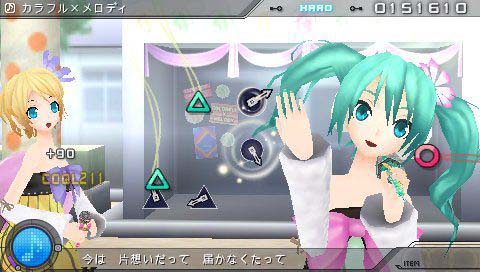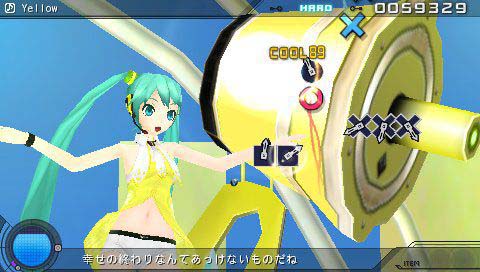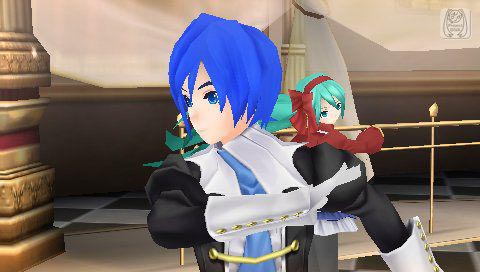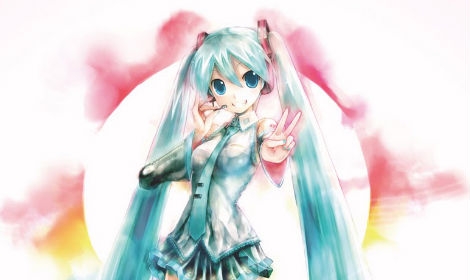The vocaloid series is a voice synthesizer program by Yamaha that makes use of various virtual idols, who were created using actual voice actors. Miku Hatsune is arguably the most famous one, used for many songs on Japanese video site Nico Nico Douga, inspiring figures, new anime Black Rock Shooter, and a music rhythm game called Hatsune Miku: Project Diva. Hatsune Miku: Project Diva 2nd is the sequel and improves upon it in many ways.
Gameplay
As music videos play in the background, blank button press queues appear on the screen. Fully colored queues fly in from the side, prompting players to press the corresponding button when the two overlap. Players will soon find that the button presses coordinate with the music being played, creating a symphony that combines sounds from the player's own button presses and the original song. This will build up the meter at the bottom left of the screen that, if filled up, allows the player to clear the song. This is par for the course as far as music rhythm games go - nothing new here. However, it’s hard to knock Sega for using a tried and true formula that makes for an overall fun game.

At times, the music videos in the back can get annoying. Because there is so much going, including things like Miku fighting a giant lizard or dancing around a field of flowers, button queues can often get lost and become hard to see; this will obviously affect performance make players miss notes here and there.
There are several new additions from the previous version. Whereas the original only had individual button prompts, Project Diva 2nd includes prolonged button prompts and double button presses, including both the d-pad and corresponding face button (i.e. down and X, right and circle, etc.). These add a new dimension for the game and make it much less monotonous. Other music rhythm games in the past have included these functions in the first iteration, which makes the list of improvements seem like features the developers held out on rather than a treat.

Chance Time seems to be unique to the Project Diva series. During a section of each song, the usual meter on the bottom left will disappear, black bars surround the screen like a widescreen movie, and players continue playing. If they do well enough, they’re rewarded with a point bonus at the end. It may not sound special. Probably because it isn’t special. It doesn’t change gameplay at all and is a useless gimmick. It’s still puzzling why this is even in the game.
Music rhythm genre veterans will also feel imprisoned by the game’s low difficulty setting. The game can be quite challenging and fun when played at the hard or extreme difficulty settings; however, players are relegated to the normal difficulty setting until they beat the song at least once. In this difficulty, the game only uses the X and O buttons and their corresponding D-pad directions, making every song an almost brain-dead procedure. If players want to have more fun with the game at the higher difficulty settings, they’d have to play through the songs twice. It’s not the biggest time investment in the world, but it’s certainly annoying and felt like a cheap way to extend replay value.

Presentation
First and foremost, this game was made for vocaloid fans. The music videos that play in the background throughout the game are sure to make any fanboy ooze, but at the same time, will look odd to someone
unfamiliar with the idol culture. The videos are still a treat though and are leaps and bounds above YouTube Miku Hatsune music videos with a still background.
The music is something else that only fanboys will appreciate - something that is an inherent problem with vocaloid music. It's not so much the selection, but more the type of vocals that vocaloids give
off. There's just no soul in them. They can't compare to an actual vocalist's work. For that reason alone, casual gamers without prior vocaloid exposure will likely see the artificial nature of the songs and be turned off. If players can get past the squeaky sound of vocaloids, then they’ll find a large catalogue of songs that range from fast to slow and rock to pop.

Dance to Your Own Music
Project Diva includes an edit mode that will allow players to use their own songs to make a playable stage. It has the same capabilities as the edit mode from the first game. This means that those dreams that music rhythm fans have of making a truly custom track list can finally be realized. However, the mode is quite technical and hard to use. Players will have to navigate through loads of menus just to get started. Definitely not import friendly. However, the potential is there if players can learn to utilize the feature.
So Many Vocaloids…But They’re All The Same!
Project Diva 2nd includes more selectable characters than just Miku; other vocaloids ranging from the popular Luka Megurine to the male Kaito are also present. However, their appearances do little more than satisfy fanboys with different vocaloid preferences. Despite having Luka or Kaito as the singer, the game still pumps out the original song, which may be sung by Miku or any of the other vocaloids. Obviously, it would be too much to expect a PSP game to include every vocaloid’s variation of the same song, considering space limitations, but it takes away from the authenticity and point of choosing different characters.
Some of the music videos were specifically made for certain vocaloids, too. In one of them, a chibi, or a child version of Miku walks through a city and suddenly transforms into a correctly proportioned version of her. Even when choosing a different character, the game still shows a chibi Miku turning into Kaito, Luka, or whichever vocaloid the player chooses. This lack of attention to detail is pretty disappointing and removes players from the experience.

It’s a fun game for any vocaloid fanboy and an enjoyable music rhythm game overall. However, players will have to get past several hurdles before before being able to fully enjoy this game – going through lower difficulties and getting used to soulless vocaloid voices are both pretty annoying for most players. Even the vocaloids themselves are a shallow form of fan service, changing nothing more than the skin of the player’s character – which is worse than the palette swaps fighting games had in the ‘90s. While noticeable, these setbacks don’t ruin the game; music rhythm and vocaloid lovers alike will still enjoy this game.

